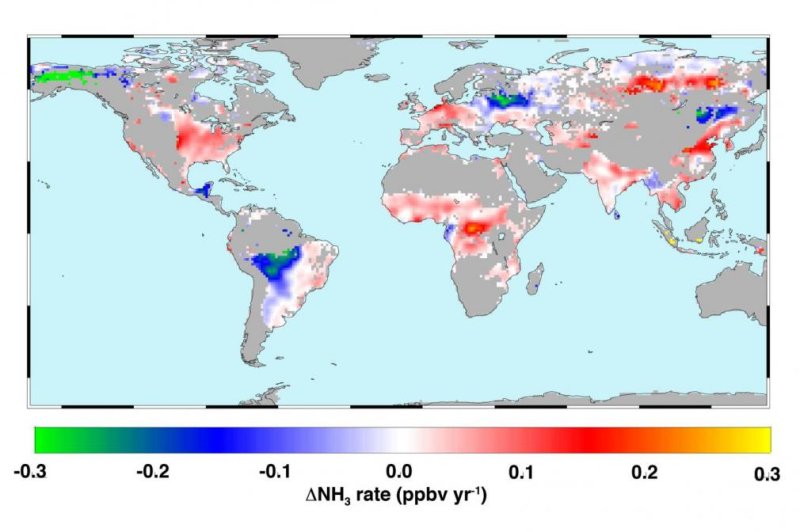Researchers at the University of Maryland found in a study that atmospheric ammonia concentrations have increased during the last decade and a half. On the map, the warmer colors show where atmospheric ammonia concentrations have increased during that time. Photo by Juying Warner/GRL
March 16 (UPI) -- Researchers at the University of Maryland used data from NASA satellites to track concentrations of ammonia in Earth's atmosphere from 2002 to 2016. They found ammonia concentrations have steadily increased above regions with high agricultural productivity.
Hotspots of atmospheric ammonia were identified above parts of the United States, Europe, China and India. The colorless gas has been linked to both environmental and human health problems.
Most excess ammonia, which can degrade air and water quality, can be traced to fertilizer use and animal waste. Researchers suggest changing atmospheric conditions and warmer soils, which absorb less ammonia, are also to blame for rising ammonia concentrations.
Scientists shared their work in the journal Geophysical Research Letters.
"Measuring ammonia from the ground is difficult, but the satellite-based method we have developed allows us to track ammonia efficiently and accurately," Juying Warner, atmospheric and oceanic science researcher at Maryland, said in a news release. "We hope that our results will help guide better management of ammonia emissions."
Fertilizer use has not increased in the United States in recent years, but scientists believe efforts to reduce acid rain have had the unintended consequence of increasing ammonia levels in the atmosphere. Acids involved in acid rain help remove ammonia from the atmosphere, but emissions standards have reduced the amount of those acids being released into the atmosphere in the United States.
"The decrease in acid rain is a good thing. Aerosol loading has plummeted -- a substantial benefit to us all," said Russell Dickerson, a professor of atmospheric and oceanic science at Maryland. "But it has also increased gaseous ammonia loading, which we can see from space."
Fertilizer use is increasing in other parts of the world. In China and India, meat is becoming a more common household menu item, as a result, livestock farming is more prevalent.
"The increase in ammonia has spiked aerosol loading in China. This is a major contributor to the thick haze seen in Beijing during the winter, for example," Warner said. "Also, meat is becoming a more popular component of the Chinese diet. As people shift from a vegetarian to a meat-based diet, ammonia emissions will continue to go up."















